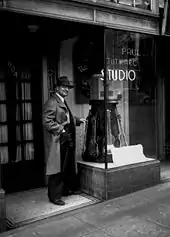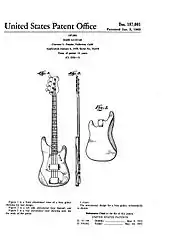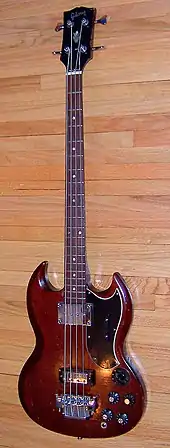Bass guitar
The bass guitar, electric bass or simply bass, is the lowest-pitched member of the string family. It is a plucked string instrument similar in appearance and construction to an electric or an acoustic guitar, but with a longer neck and scale length, and typically four to six strings or courses. Since the mid-1950s, the bass guitar has largely replaced the double bass in popular music.
 Fender Jazz Bass | |
| String instrument | |
|---|---|
| Other names | Bass, bass guitar, electric bass |
| Classification | String instrument |
| Hornbostel–Sachs classification | 321.322 (Composite chordophone) |
| Inventor(s) | Paul Tutmarc, Leo Fender |
| Developed | 1930s |
| Playing range | |
 Range of a standard tuned 4-string bass guitar (brackets: 5-string) | |
| Related instruments | |
| |
The four-string bass is usually tuned the same as the double bass, which corresponds to pitches one octave lower than the four lowest-pitched strings of a guitar (typically E, A, D, and G). It is played primarily with the fingers or thumb, or with a pick. To be heard at normal performance volumes, electric basses require external amplification.
Terminology
According to the New Grove Dictionary of Music and Musicians, an "Electric bass guitar [is] a Guitar, usually with four heavy strings tuned E1'–A1'–D2–G2."[1] It also defines bass as "Bass (iv). A contraction of Double bass or Electric bass guitar." According to some authors the proper term is "electric bass".[2][3] Common names for the instrument are "bass guitar", "electric bass guitar", and "electric bass"[4] and some authors claim that they are historically accurate.[5]
Scale
The scale of the bass is located along the length of the string and forms what is known as the fingerboard. The scale can range in length but is traditionally 34-35 inches long while "short scale" bass guitars are usually between 30 and 32 inches.[6]
Pickup
Bass pickups are generally attached to the body of the guitar and located beneath the strings. They are responsible for translating the physical energy from a person plucking the strings, to electrical energy that is sent to an amplifier to create sound.[7]
Strings
Bass guitar strings are made up of two main components: the core and the winding. The core is the central wire that runs through the center of the string and is generally made up of steel, nickel or some alloy.[8] The difference in material can have an effect on the sound of the bass guitar. There are four main methods of string winding: roundwound, flatwound, tapewound, and groundwound (half-round). The difference in winding also has an impact on the sound of the bass guitar, but the most commonly found winding is the roundwound, which involves the core wire being wrapped with another round-shaped wire.[9]
Roundwound strings are the most popular form of strings on bass guitars and are known for producing a tone with more harmonics. The next most common string found on bass guitars are flatwound strings. Flatwound strings are known for a smoother sound and feel compared to roundwound strings. Tapewound strings are similar to flatwound strings except, tapewound strings are wrapped in a non-metal material, such as nylon, giving an even slicker feel and a fuzzier tone.[10]
History
1930s

In the 1930s, musician and inventor Paul Tutmarc of Seattle, Washington, developed the first electric bass guitar in its modern form, a fretted instrument designed to be played horizontally. The 1935 sales catalog for Tutmarc's company Audiovox featured his "Model 736 Bass Fiddle", a solid-bodied electric bass guitar with four strings, a 30+1⁄2-inch (775-millimetre) scale length, and a single pickup.[11] Around 100 were made during this period.[12] Audiovox also sold their "Model 236" bass amplifier.[13]
1950s

In the 1950s, Leo Fender and George Fullerton developed the first mass-produced electric bass guitar.[14] The Fender Electric Instrument Manufacturing Company began producing the Precision Bass, or P-Bass, in October 1951. The design featured a simple uncontoured "slab" body design and a single coil pickup similar to that of a Telecaster. By 1957 the Precision more closely resembled the Fender Stratocaster with the body edges beveled for comfort, and the pickup was changed to a split coil design.[15]

The Fender Bass was a revolutionary instrument for gigging musicians. In comparison with the large, heavy upright bass, which had been the main bass instrument in popular music from the early 20th century to the 1940s, the bass guitar could be easily transported to shows. When amplified, the bass guitar was also less prone than acoustic basses to unwanted audio feedback.[16] The addition of frets enabled bassists to play in tune more easily than on fretless acoustic or electric upright basses, and allowed guitarists to more easily transition to the instrument.[17]
In 1953, Monk Montgomery became the first bassist to tour with the Fender bass, in Lionel Hampton's postwar big band.[18] Montgomery was also possibly the first to record with the electric bass, on July 2, 1953, with the Art Farmer Septet.[19] Roy Johnson (with Lionel Hampton), and Shifty Henry (with Louis Jordan and His Tympany Five), were other early Fender bass pioneers.[14] Bill Black, who played with Elvis Presley, switched from upright bass to the Fender Precision Bass around 1957.[20] The bass guitar was intended to appeal to guitarists as well as upright bass players, and many early pioneers of the instrument, such as Carol Kaye, Joe Osborn, and Paul McCartney were originally guitarists.[16]
Also in 1953, Gibson released the first short-scale violin-shaped electric bass, the EB-1, with an extendable end pin so a bassist could play it upright or horizontally. In 1958, Gibson released the maple arched-top EB-2 described in the Gibson catalog as a "hollow-body electric bass that features a Bass/Baritone pushbutton for two different tonal characteristics". In 1959, these were followed by the more conventional-looking EB-0 Bass. The EB-0 was very similar to a Gibson SG in appearance (although the earliest examples have a slab-sided body shape closer to that of the double-cutaway Les Paul Special). The Fender and Gibson versions used bolt-on and set necks.
Several other companies also began manufacturing bass guitars during the 1950s. 1956 saw the appearance at the German trade fair "Musikmesse Frankfurt" of the distinctive Höfner 500/1 violin-shaped bass, made using violin construction techniques by Walter Höfner, a second-generation violin luthier.[21] Due to its use by Paul McCartney, it became known as the "Beatle bass".[22] In 1957, Rickenbacker introduced the model 4000, the first bass to feature a neck-through-body design in which the neck is part of the body wood.[23] Kay Musical Instrument Company began production of the K-162 in 1952, Danelectro released the Longhorn in 1956, and Burns London/Supersound in 1958.[20]
1960s

With the explosion in popularity of rock music in the 1960s, many more manufacturers began making electric basses, including Yamaha, Teisco and Guyatone. Introduced in 1960, the Fender Jazz Bass, initially known as the "Deluxe Bass", used a body design known as an offset waist which was first seen on the Jazzmaster guitar in an effort to improve comfort while playing seated.[24] The J-bass features two single-coil pickups.
Providing a more "Gibson-scale" instrument, rather than the 34 inches (864 mm) Jazz and Precision, Fender produced the Mustang Bass, a 30-inch (762 mm) scale-length instrument.[25] The Fender VI, a 6 string bass, was tuned one octave lower than standard guitar tuning. It was released in 1961, and was briefly favored by Jack Bruce of Cream.[26]
Gibson introduced its short-scale 30.5-inch (775 mm) EB-3 in 1961, also used by Bruce.[27] The EB-3 had a "mini-humbucker" at the bridge position. Gibson basses tended to be instruments with a shorter 30.5" scale length than the Precision. Gibson did not produce a 34-inch (864 mm)-scale bass until 1963 with the release of the Thunderbird.[28]
The first commercial fretless bass guitar was the Ampeg AUB-1, introduced in 1966.[29] In the late 1960s, eight-string basses, with four octave paired courses (similar to a 12 string guitar), were introduced, such as the Hagström H8.[30]
1970s

In 1972, Alembic established what became known as "boutique" or "high-end" electric bass guitars.[31] These expensive, custom-tailored instruments, as used by Phil Lesh, Jack Casady, and Stanley Clarke, featured unique designs, premium hand-finished wood bodies, and innovative construction techniques such as multi-laminate neck-through-body construction and graphite necks. Alembic also pioneered the use of onboard electronics for pre-amplification and equalization.[32][33] Active electronics increase the output of the instrument, and allow more options for controlling tonal flexibility, giving the player the ability to amplify as well as to attenuate certain frequency ranges while improving the overall frequency response (including more low-register and high-register sounds). 1976 saw the UK company Wal begin production of their own range of active basses.[34] In 1974 Music Man Instruments, founded by Tom Walker, Forrest White and Leo Fender, introduced the StingRay, the first widely produced bass with active (powered) electronics built into the instrument.[35] Basses with active electronics can include a preamplifier and knobs for boosting and cutting the low and high frequencies.
In the mid-1970s, five-string basses, with a very low "B" string, were introduced. In 1975, bassist Anthony Jackson commissioned luthier Carl Thompson to build a six-string bass tuned (low to high) B0, E1, A1, D2, G2, C3, adding a low B string and a high C string.[36]
Fretless bass guitars

While electric bass guitars are traditionally fretted instruments, fretless bass guitars are used by some players to achieve different tones, as well as playing additional micro tones. In 1961, Rolling Stones bassist Bill Wyman converted a used UK-built Dallas Tuxedo bass by removing the frets and filling in the slots with wood putty.[16]
See also
- Acoustic bass guitar
- Fretless bass
- Bass guitar tuning
- Bass instrument amplification
- Bass effects
- Pickups
- List of bass guitar manufacturers
- List of bass guitarists
References
- Sadie & Tyrrell 2001.
- Wheeler 1978, pp. 101–102.
- Evans & Evans 1977, p. 342.
- Bacon & Moorhouse 2016.
- Roberts 2001, References Appendix.
- Trinidad, Chris (2004). "Music Makers: Bass Guitar - The Case for Bass Guitar: Concepts and Suggestions for Non-Bass Guitarists". Canadian Music Educator. 45: 35–39.
- Veall, Dan (December 21, 2020). "Bass guitar pickups explained". Bass Player. Retrieved March 1, 2022.
- Koester, Thom (August 24, 2020). "What Are Guitar Strings Made Of?". Sweetwater Sound. Retrieved February 17, 2022.
- Owens, Jeff. "Bass Strings 101". Fender. Retrieved February 17, 2022.
- Brody, Mark (January 30, 2020). "Flatwound vs. Roundwound Bass Strings". Sweetwater Sound. Retrieved March 1, 2022.
- Blecha, Peter (December 11, 2001). "Audiovox #736: The World's First Electric Bass Guitar!". Vintage Guitar. Retrieved February 17, 2019.
- Roberts 2001, pp. 28–29.
- "Audiovox and Serenader Amps – An Interview with Bud Tutmarc". Vintage Guitar. February 19, 2002. Retrieved February 17, 2019.
- Slog & Coryat 1999, p. 154.
- Owens, Jeff (March 13, 2019). "Legendary Lows: The Precision Bass Story". Fender. Retrieved January 7, 2020.
- Roberts 2001.
- Rogers, Dave; Braithwaite, Laun; Mullally, Tim (May 13, 2013). "1952 Fender Precision Bass". Premier Guitar. Retrieved January 7, 2020.
- George 1998, p. 91.
- Mulhern, Tom (1993). Bass heroes: styles, stories & secrets of 30 great bass players: from the pages of Guitar player magazine. San Francisco: GPI Books. p. 165. ISBN 0-585-34936-3. OCLC 47008985.
- Bacon 2010.
- "A Short History of Hofner". Retrieved January 1, 2021.
- Bacon & Moorhouse 2016, eBook.
- "The Modern Era of the electric Guitar". Rickenbacker. Retrieved January 1, 2021.
- Owens, Jeff (June 12, 2019). "Jaco, Geddy and Flea Can't Be Wrong: The Story of the Jazz Bass". Fender.
Most apparent was a feature borrowed from the Jazzmaster—an offset waist—that conveyed a sleeker and more curvaceous look to the Jazz Bass. In true Fender fashion, however, this was an innovation rooted not in form but in function — the sexier look was a by-product of the more practical consideration that the offset waist made the instrument more comfortable to play when seated.
- "Mustang Bass". sFender. Retrieved January 1, 2021.
- "Jack Bruce - Equipment". Jackbruce.com. Retrieved January 1, 2021.
- Moseley, Willie G. (March 10, 2010). "The Gibson EB-3". Vintage Guitar. Retrieved September 5, 2017.
- Mullally, Tim; Braithwaite, Laun; Rogers, Dave (March 5, 2017). "Vintage Vault: 1964 Gibson Thunderbird Bass". Premier Guitar. Retrieved January 1, 2021.
- Roberts 2001, p. 125–126.
- "Hagstrom H8-II Bass". Hagström. Retrieved September 29, 2017.
- "Alembic - History, Short Version". Alembic. Retrieved February 4, 2021.
- "Alembic Activators". Alembic. Retrieved February 4, 2021.
- Fletcher, Tim (March 16, 2020). "The History of Active Electronics". Bass Musician. Retrieved February 4, 2021.
- "About Us". Walbasses. Retrieved December 31, 2020.
- "StingRay". Music Man. Retrieved February 4, 2021.
- Roberts, Jim (July 23, 2019). "Partners: Anthony Jackson & Fodera Guitars". Bass Magazine. Retrieved January 1, 2022.
Bibliography
- Bacon, Tony (2010). 60 Years of Fender: Six Decades of the Greatest Electric Guitars. Backbeat Books. ISBN 978-0879309664.
- Bacon, Tony; Moorhouse, Barry (2016). The Bass Book: A Complete Illustrated History of Bass Guitars. Backbeat Books. ISBN 978-1-4950-0150-5.
- Black, J. W. (2001). The Fender Bass: An Illustrated History. Hal Leonard. ISBN 0-634-02640-2.
- Boyer, Paul (2013). The Rickenbacker Electric Bass: 50 Years As Rock's Bottom. Hal Leonard. ISBN 978-1-4768-8680-0.
- Evans, Tom; Evans, Mary Ann (1977). Guitars: From the Renaissance to Rock. Facts On File. ISBN 0-87196-636-0.
- George, Nelson (1998). Hip Hop America. Viking Press. ISBN 978-0-670-87153-7.
- Roberts, Jim (2001). How The Fender Bass Changed the World. San Francisco, California: Backbeat Books. ISBN 0-87930-630-0.
- Sadie, Stanley; Tyrrell, John (2001). The New Grove Dictionary of Music and Musicians (Second ed.). London.
- Slog, John J.; Coryat, Karl (1999). The Bass Player Book: Equipment, Technique, Styles and Artists. Backbeat Books. ISBN 0-87930-573-8.
- Trynka, Paul (1996). Rock Hardware. Hal Leonard. ISBN 0-87930-428-6.
- Wheeler, Tom (1978). The Guitar Book: A Handbook for Electric and Acoustic Guitarists. Harper & Row. ISBN 0-06-014579-X.